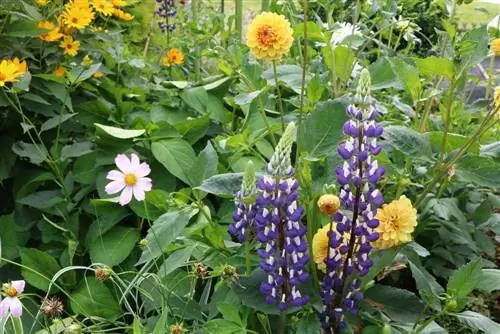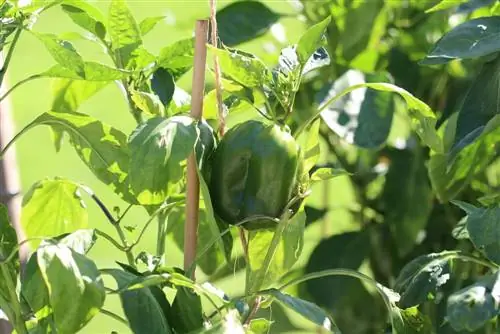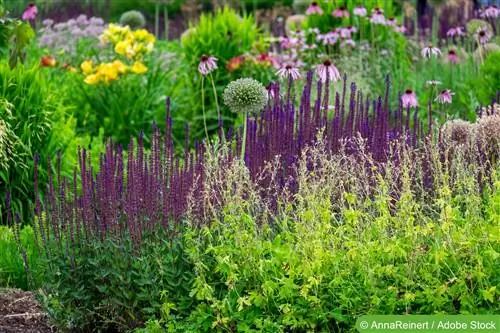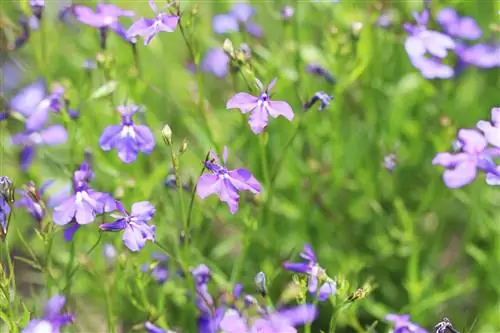- Author admin [email protected].
- Public 2023-12-17 03:39.
- Last modified 2025-01-24 12:45.
Columbine, fool's cap or elf glove Behind all these names lies a beautifully flowering, versatile and easy-care plant. Anyone who pays attention to a few points in their culture will bring a decorative addition to their garden.
Choose the right location
The Columbine prefers a sunny location with moving shade. Areas directly next to the house or in the immediate vicinity of taller bushes and trees are ideal. However, some caution is required, because no matter how simple the fool's cap's requirements for the location may be, it does not tolerate competition from surrounding areas very well. Therefore, it thrives better on lawn edging stones or bed borders than surrounded by other plants.
Substrate
In order to thrive properly and form the typical, visually thorny flowers, the columbine needs some nutrients and a consistent moisture content. The substrate should therefore be loose and somewhat permeable to water and have a high nutrient content. Fresh garden soil mixed with a little compost and coconut fiber or sand is very suitable.
Sowing
Sowing is somewhat complicated due to the tiny size of the seeds. And requires at least a certain degree of tact. However, it is possible in two ways. On the one hand, the seeds can be sown directly into the bed. On the other hand, it can be grown in a pot.
Sowing outdoors
- The older columbine is unaffected by frost, unlike the seeds and young plants.
- Sowing outdoors may therefore only take place when the last late frost has passed.
- The higher the ground temperature already is, the better. But it should be at least 15 °C.
- It is important to keep the shoots evenly moist in the first few months and thin them out if necessary.
- This can also be more difficult in the bed than with columbine plants that have been grown early.
Preparing on the windowsill
If you decide to prefer it, it will be easier for you to plant the seeds. Because this is possible at any time in the room:
- Normal room temperatures, a bright location and some potting soil - that's all the columbine needs to sprout quickly.
- The only thing that needs to be carefully considered here is the moisture. The plants must not dry out at any time.
- If the young plants are already a few centimeters high, they should be sorted out. All obviously weak shoots must be removed.
- After sorting out, the strong shoots have more space and receive more nutrients.
- After the last frost in spring, the early fool's caps can be put to bed.
- It is best to do this directly with the potting soil. Because the shoots are very delicate and break off at the slightest touch.
Anyone who has sown the columbine and planted it in the bed can breathe a sigh of relief. As a result, the plants self-seed.
Care
The young columbine needs a lot of water. Once it has reached its full size, watering in dry times and normal rainfall are sufficient. The second point of care is annual fertilization. This fertilization is ideally carried out after the first flowering phase of the year. Horn shavings and compost are suitable. If the plant shows weakness, you can fertilize it more often. Biological and organic fertilizers are preferable. Depending on the nature of the soil, mineral agents can also be administered after an examination.
Cutting
Columbine clippings occur once or twice a year. That depends on how often you want it to bloom. If it is trimmed and fertilized immediately after the first flowering phase, it will bloom again in the fall. If the flowers are left directly on it, the columbine will expand, but will wilt until winter. It is advisable to cut it off after the first flowering, but leave the second inflorescence on it until next spring. After winter and before the first shoots, the columbine can be radically cut back to just above the ground. The fool's cap usually copes with this very well and sprouts again stronger and denser.
Wintering
If the columbine was planted freely in the bed in spring, it had plenty of opportunity to develop an extensive root network during the warm months. This will help her over the winter. Additional protection is therefore usually not necessary. Appropriate measures should only be taken if the location is very unprotected or a long winter with extremely sub-zero temperatures is expected. It makes sense to cover the plant with a thick layer of mulch, straw and brushwood. Since it wilts in autumn anyway and retreats into the roots, you can also put a bucket over it. Digging up in autumn and replanting in spring is not recommended because a large part of the roots will be injured or even separated. An alternative, however, could be to cultivate the columbine in a bucket and move it to an unheated but frost-free location in the house during the winter. The plant does not need light during this resting phase.
Is columbine poisonous?
As beautiful as the flowers and blue-green leaves of the columbine are, they should not hide their toxicity. Even small amounts cause severe symptoms and symptoms of poisoning. These include:
- Nausea
- Vomiting
- Diarrhea
- Dizziness and dizziness
- Difficulty breathing
- Heart problems
The fool's cap does not belong near herb and vegetable beds, where young shoots could accidentally end up in lettuce or pots. They should still be accessible to children and pets, who could tear off the colored flowers or pick up parts of the plant while playing.
What you should know about Columbine soon
Columbine is a rich and interesting flowering plant that is available in a variety of sizes and colors. Once sown, it can become a constant companion in the garden that requires little care and is still a beautiful eye-catcher. This makes it ideal for cottage gardens and anyone who doesn't want to invest a lot of time or effort in gardening but still wants to enjoy the splendor of flowers.
- Columbine is a poisonous plant, but in ancient times it was used as a medicine against kidney and liver diseases.
- The plant was already known for its healing powers in the 17th century. The columbine (its seeds) was even said to have an aphrodisiac effect.
- The flowers contain the poison prussic acid.
- The flower colors and shapes of the Columbine range from white, yellow, pink, blue, bicolor to a fascinating almost black flower color (Columbine 'William Guinness').
- The flowering period is from May to June.
- Propagation can be done by sowing March to June. Sow only flat and provide some shade.
- Only purchased, cultivated seeds are colorfast. Self-collected seeds can create a colorful mess.
- If you want to prevent self-sowing, cut off the withered stems. This also encourages a second flowering in autumn.
- Columbine feels at home in the company of bleeding heart, astilbe, ferns, daylilies, phlox and other perennials that thrive in partial shade or sun.
The columbine is an extremely undemanding plant, but you cannot always avoid infestation by the columbine gall midge. This pest attacks the buds of the columbine. Be sure to destroy affected buds. Do not throw it in the compost. Another pest is mealybugs. The shoots are covered with a cotton-like material and you can see shiny, sticky spots on the plant. The lice underneath suck on the leaves and shoots and excrete harmful substances, just like aphids. A strong shower with a garden hose and, as with aphids, a mixture of water, soft soap and a splash of alcohol often help against mealybugs. Unfortunately, columbines near roses and phlox are also affected by powdery mildew. In this case, a 1:1 mixture of water and fresh whole milk (3.6% fat, not UHT milk) helps. This mixture is also very helpful for roses, monarda and phlox affected by powdery mildew. Spray plants with this mixture until dripping wet, if necessary repeat the treatment 3-5 times at intervals of 2-4 days.
Popular species
- Aquilegia akitensis: Dwarf columbine. The Ministar variety blooms from May to June, is only approx. 15 cm high, has dark blue flowers and white calyx tips. Ideal location: rock gardens in sun and partial shade. Also suitable as a cut flower for small bouquets. (similar to scented violets)
- Columbine buergeriana: dwarf columbine. The Calimero variety blooms from May to June and grows to a height of approx. 20 cm. The flower is aubergine-colored on the outside, the inner bells are a delicate yellow color. Ideal location like Ministar.
- Columbine superba: Forms very large flowers, blooms from May to June. Reaches a height of about 40-45 cm. Is planted with great preference in rock gardens, where it also feels very comfortable. It is often used as a cut flower, for wildflower bouquets or with other early summer bloomers. (Freesia, anemones, etc.)






